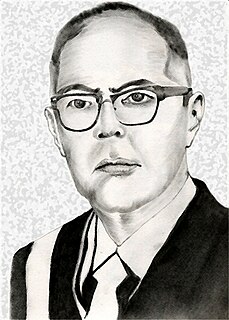
The Democratic Solidarity Party was a political liberal party in Cuba. Although changes to the Cuban constitution in 1992 decriminalized the right to form political parties other than the Communist Party of Cuba, these parties are not permitted to campaign or engage in any public political activities on the island. The Democratic Solidarity party describes itself as "an organization from within Cuba promoting democracy and the respect for human rights by the peaceful route." The President of the party is Fernando Sánchez López. The party is a full member of Liberal International.
The Cuban Revolutionary Party – Authentic, commonly named Authentic Party, was a political party in Cuba most active between 1933 and 1952. Although the Partido Auténtico had significant influence, it eventually became unpopular and, despite significant reforms, Fulgencio Batista returned to power.
Mario Carreño y Morales was a Cuban painter.

Emilio Ochoa was a Cuban dentist and politician. Believed to be the last living signatory of Cuba's 1940 Constitution, he served as Senator (1940–1948) and became part of the opposition against both dictators Fulgencio Batista and Fidel Castro, ultimately going into exile in the 1960s.
Adriano Buergo, is a Cuban artist specializing in painting, drawing and installations.
The Cuban National League was a political party in Cuba. The league was one of two political groupings that emerged from the Junta Patriótica in Havana in March 1899.
The Cuban Socialist Party was a political party in Cuba. The party was founded in March 1899 by Diego Vicente Tejera. The founding of the Socialist Party represented the first attempt in Cuban history to build a political party representing the working class.
The People's Labour Party was a short-lived political party in Cuba. It appeared in public with its programme in August 1901. The party was a continuation of the People's Party of Diego Vicente Tejera. However, it appears that Diego Vicente Tejera had no links to the People's Labour Party.
The Saguan Democratic Party was a short-lived political party in Sagua la Grande, founded in 1899. The party was led by Calixto Casals, José V. Andreu and Eduardo F. Rodríguez. The party gathered local interests which opposed the U.S. military occupation of Cuba.
The People's Party was a short-lived political party in Cuba. It was founded on November 7, 1900 by Diego Vicente Tejera. The People's Party sought to mobilize the working class of Cuba into political action. However the party failed to make any significant political breakthrough. Tejera took part in the Constituent Convention of 1901 as a delegate from the People's Party.
The Republican Party of Havana was a political party in Cuba. The party was founded in the end of 1899. It was led by Dr. Domingo Méndez Capote. Prominent party members included Mario García Menocal, Eugenio Sánchez Agramonte, Fernando Freyre de Andrade, Manuel María Coronado, Manuel Despaigne and Juan Gualberto Gómez.
The Federal Republican Party of Las Villas was a political party in Las Villas, Cuba. The party was founded in 1899 by the provincial governor José Miguel Gómez and Carlos Mendieta y Montefur. Pelayo García Santiago was the president of the party. Prominent party members included General José B. Alemán, Dr. Rafael Martínez Ortíz, General José de J. Monteagudo, José Manuel Berenguer, Francisco López Leyva, Lic. Benito Besada, José L. Robau, Eduardo Domínguez, Dr. Orestes Ferrara and Enrique Villuendas.
The Independent Republican Party was a political party in Cuba, led by Juan Gualberto Gómez. It was formed around 1900, after splits in the Republican parties in Havana, Matanzas and Las Villas. The split was caused by the opposition of the Republican parties to Gualberto Gómez's radical position against the Platt Amendment. The Independent Republican Party supported Gualberto Gómez's position on the issue.
Municipal elections were held in Cuba on June 16, 1900. The elections were held under the auspices of the U.S. Military Government with a system of restricted suffrage. 7% of the Cuban population took part in the polls, which saw some important victories for pro-independence sectors.

A general election was held in Honduras on March 28, 1971. Voters went to the polls to elect a new President of the Republic and a new Congress.

José Manuel Fors is a contemporary Cuban artist born in Havana in 1956. His work is principally supported by the installation and the handling of photography as a support for his instalative practice. His first artistic forays, during the early eighties, were part of what has been considered as "The Renaissance of Cuban Art". His artworks have been shown in renowned museums and galleries in the United States, Europe and Cuba.

Manuel A. Iturralde-Vinent, is a Cuban geologist and paleontologist and former deputy director of the Cuban National Natural History Museum in Havana. He is a scientific personality in Cuba and the Caribbean and President of the Cuban Geological Society for 2007-2016.
María Digna Collazo y del Castillo was a Cuban midwife, essayist, editor, suffragist, and feminist activist. She was one of the architects of Cuba's women's suffrage campaign of the 1910s, along with Amalia Mallén and Aída Peláez de Villa Urrutia. To this end, she participated in the foundation of the first organizations that sought to allow women to vote in her country, such as the Cuban Suffragists (1912) and the National Suffragist Party (1913) – of which she was vice president. Furthermore, together with Carmen Velacoracho de Lara, she founded the Feminist Party in 1918.






